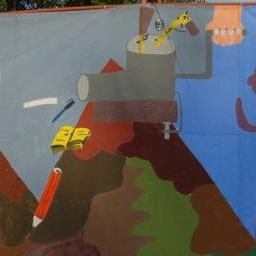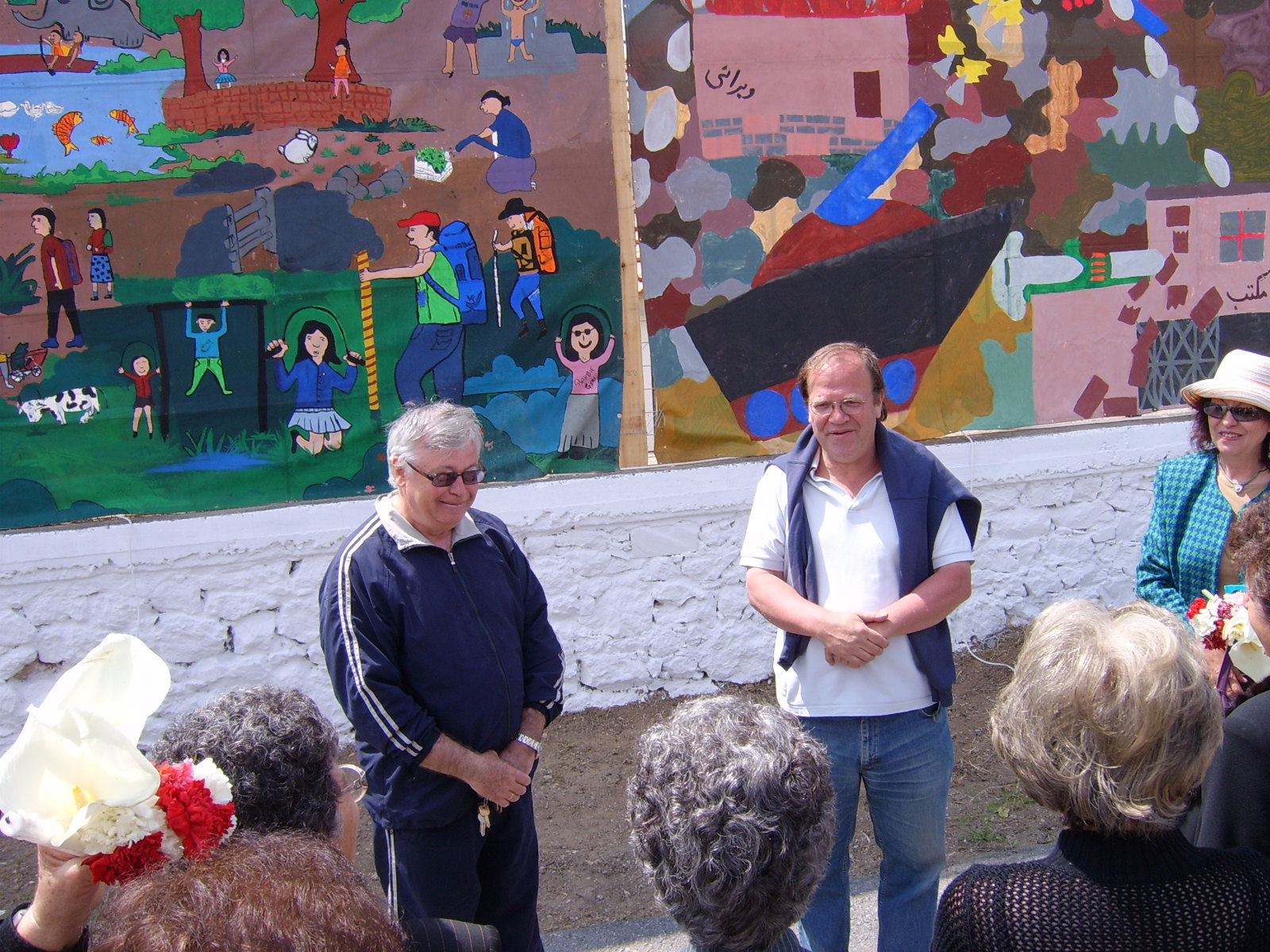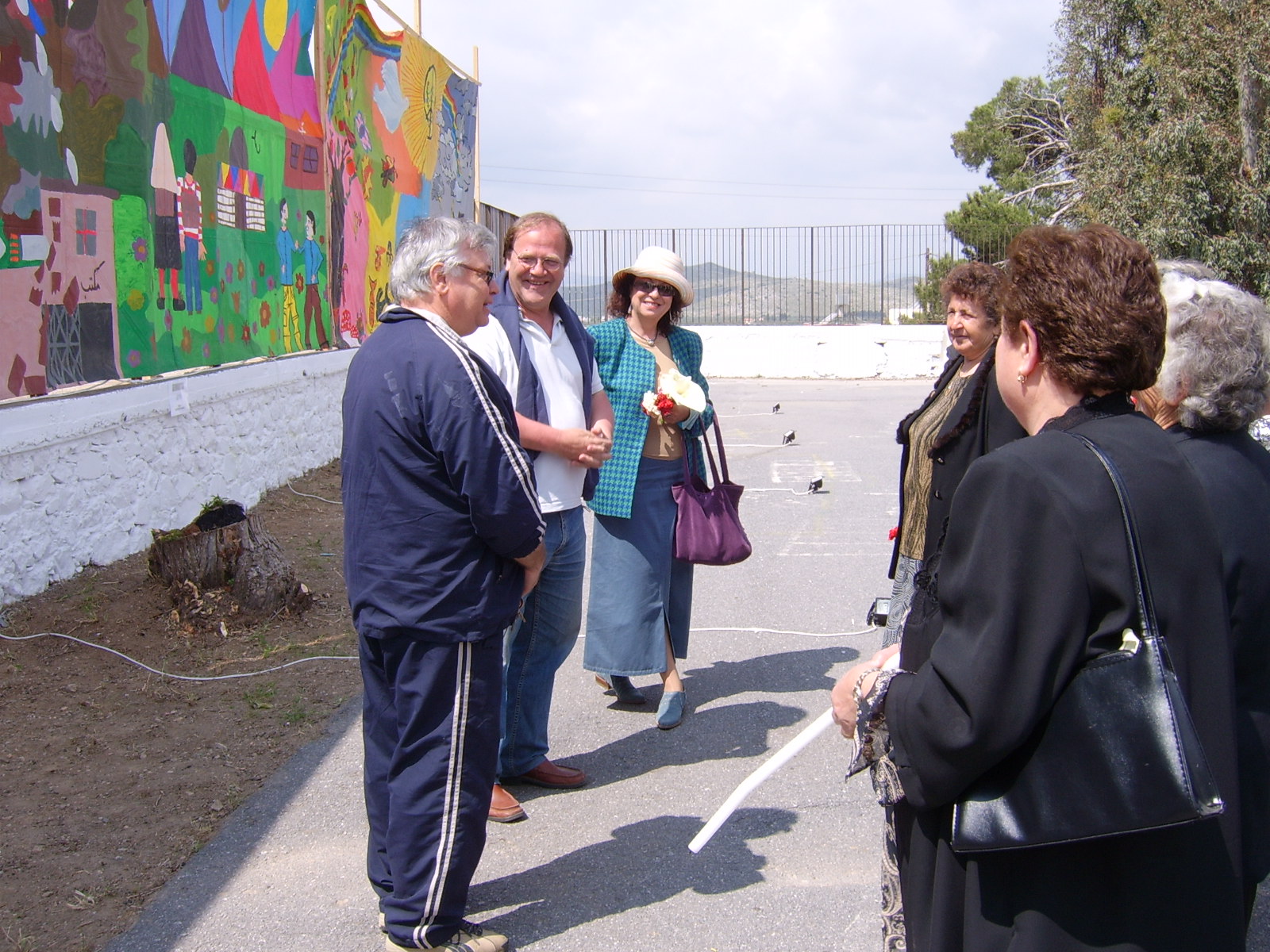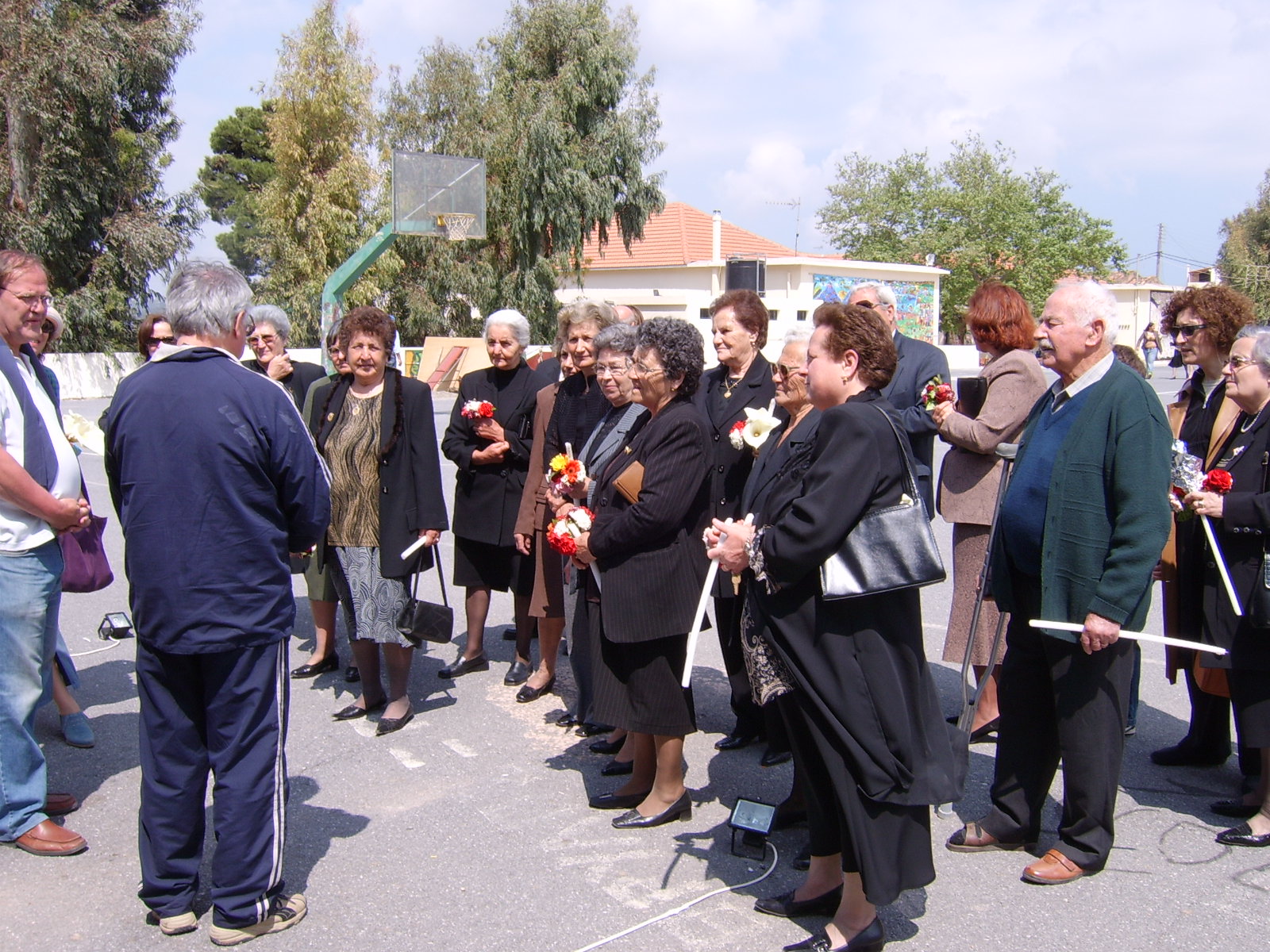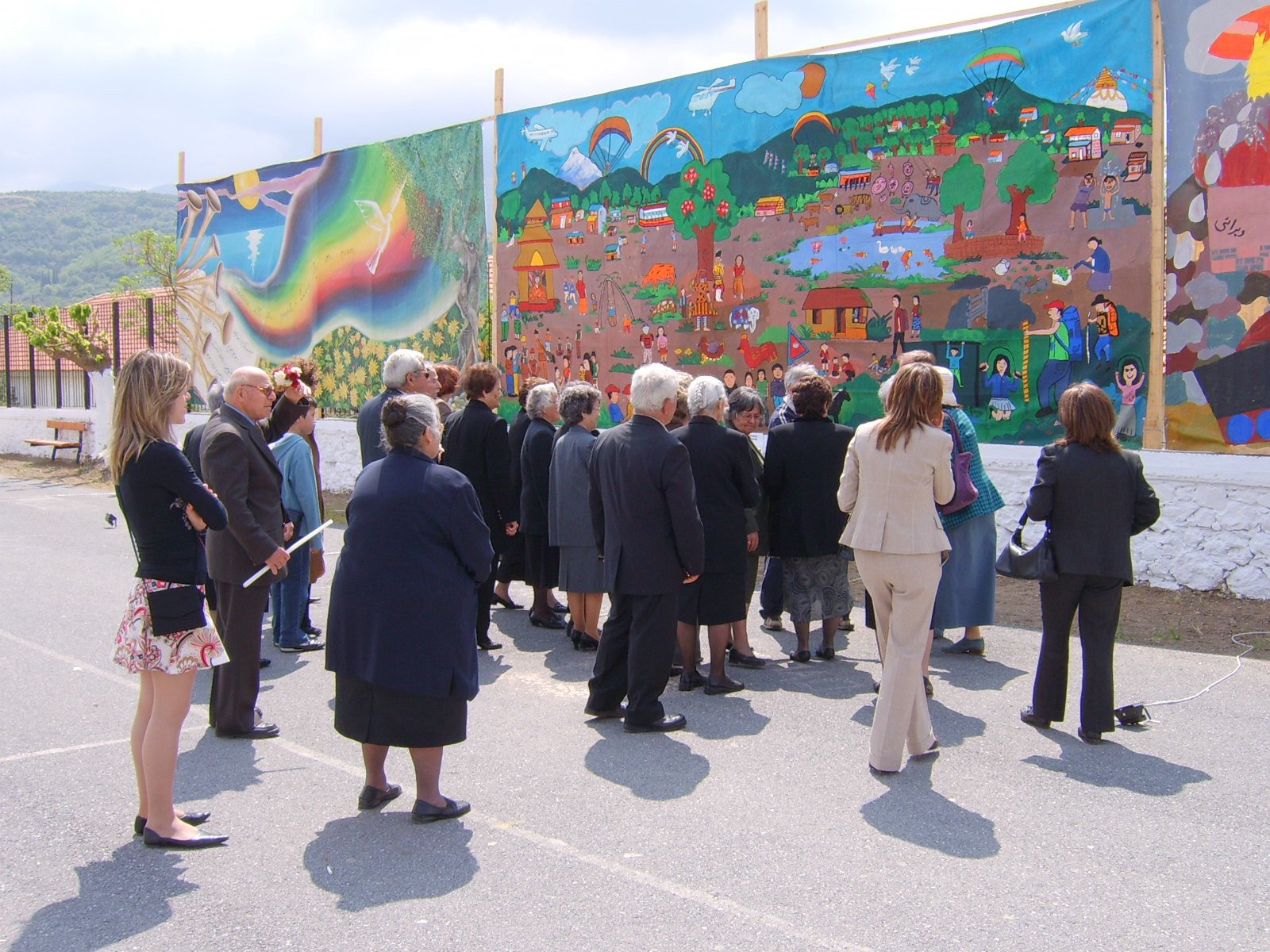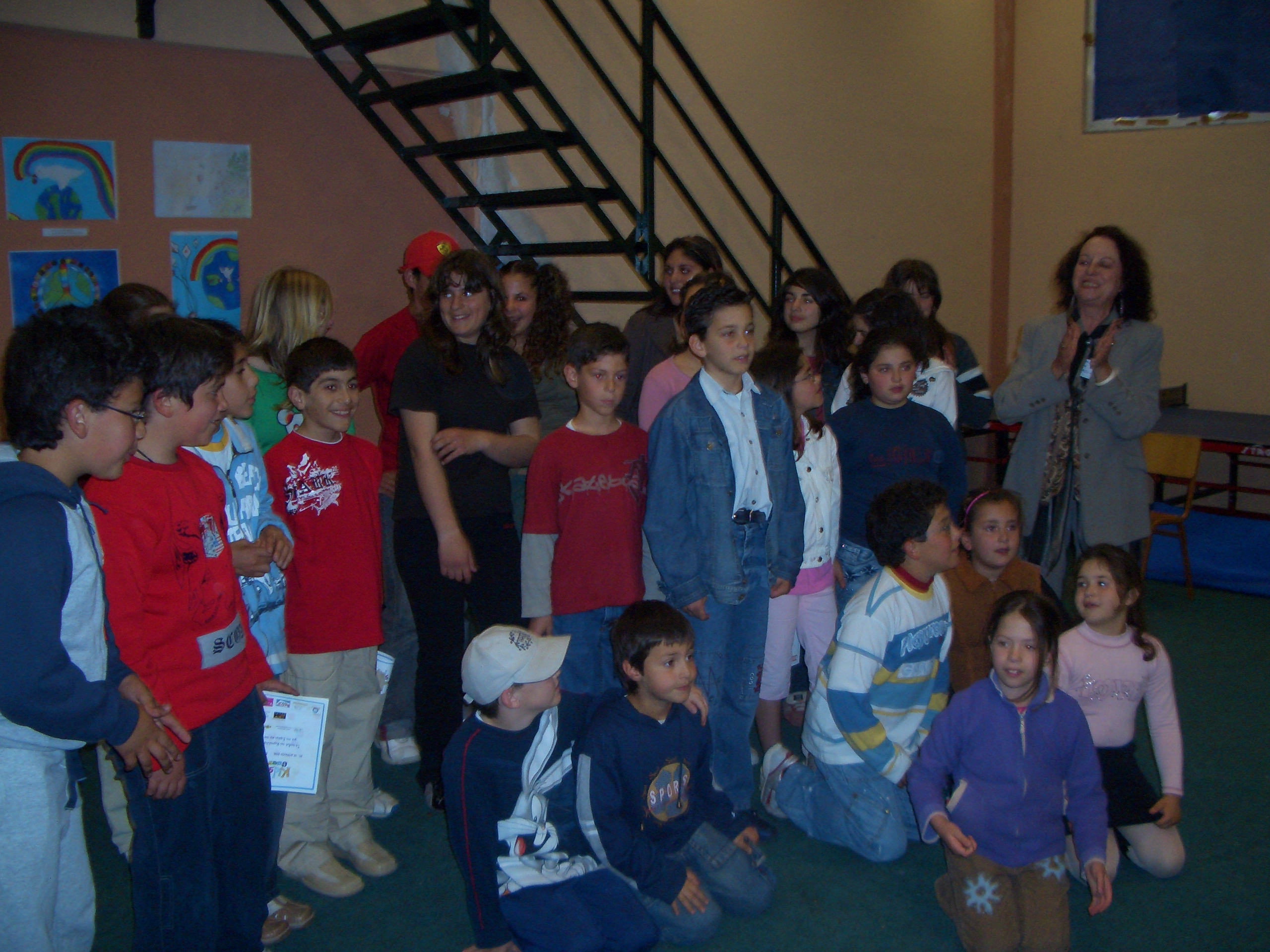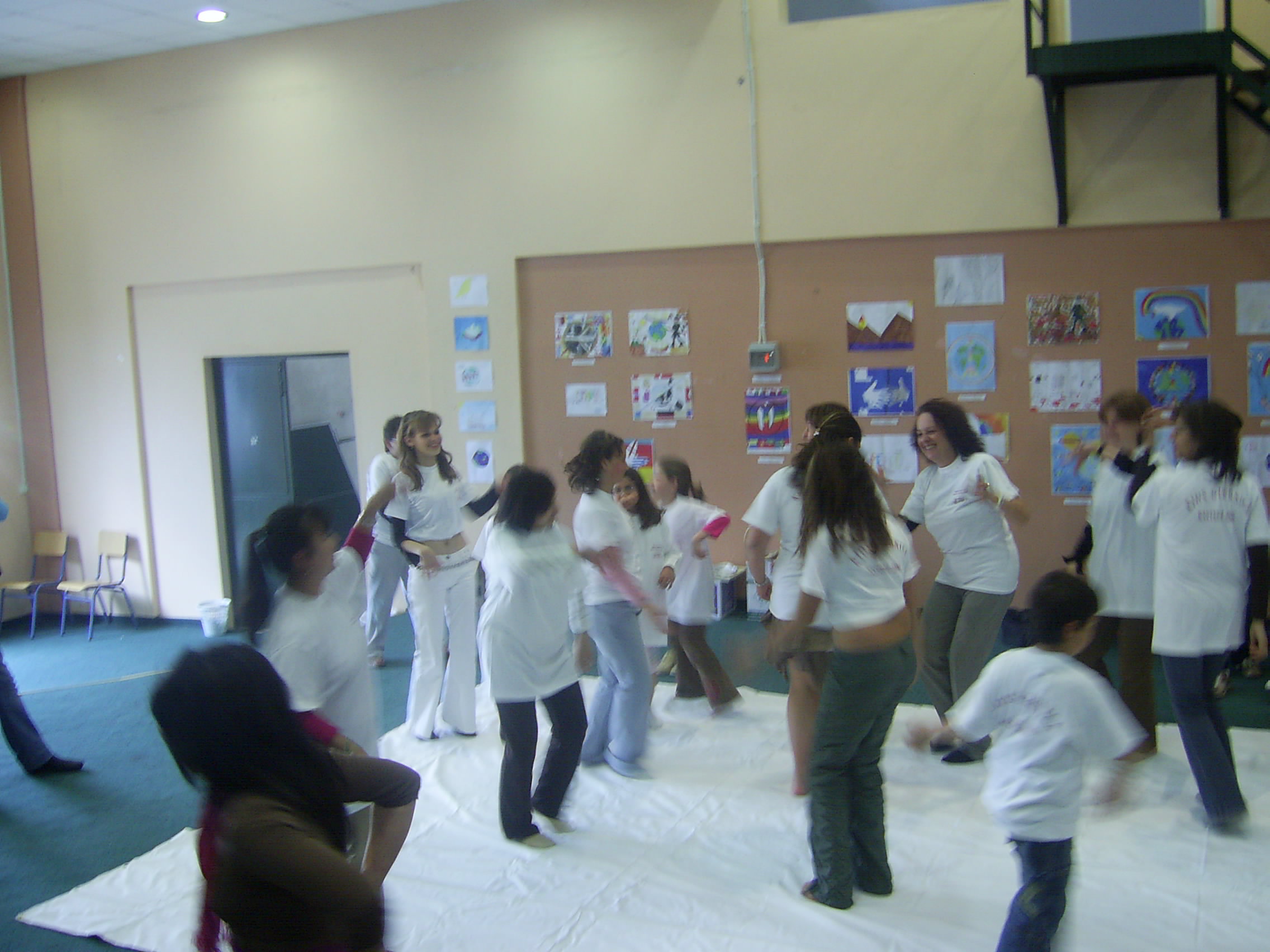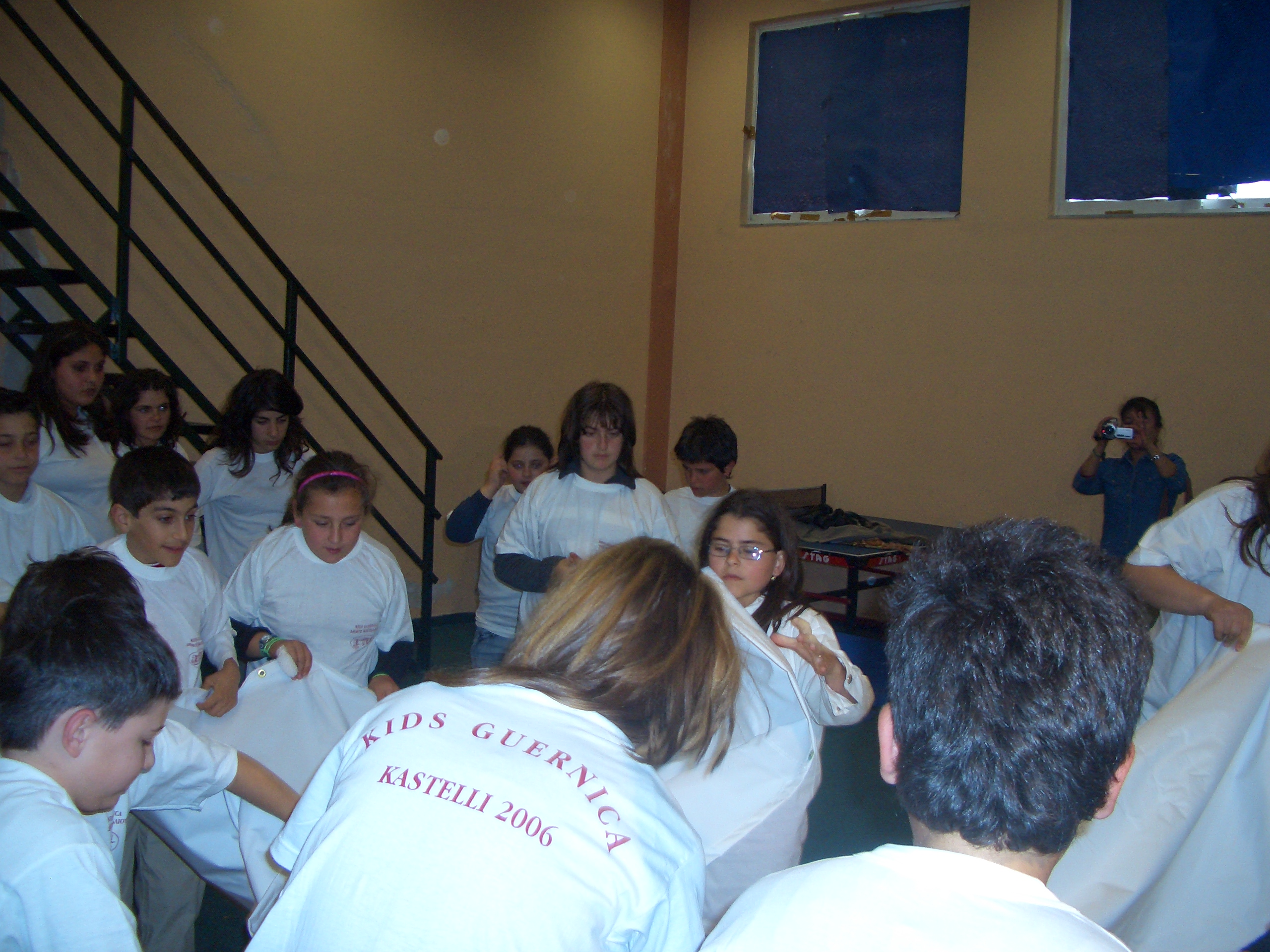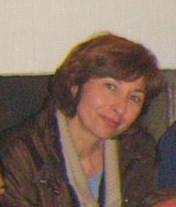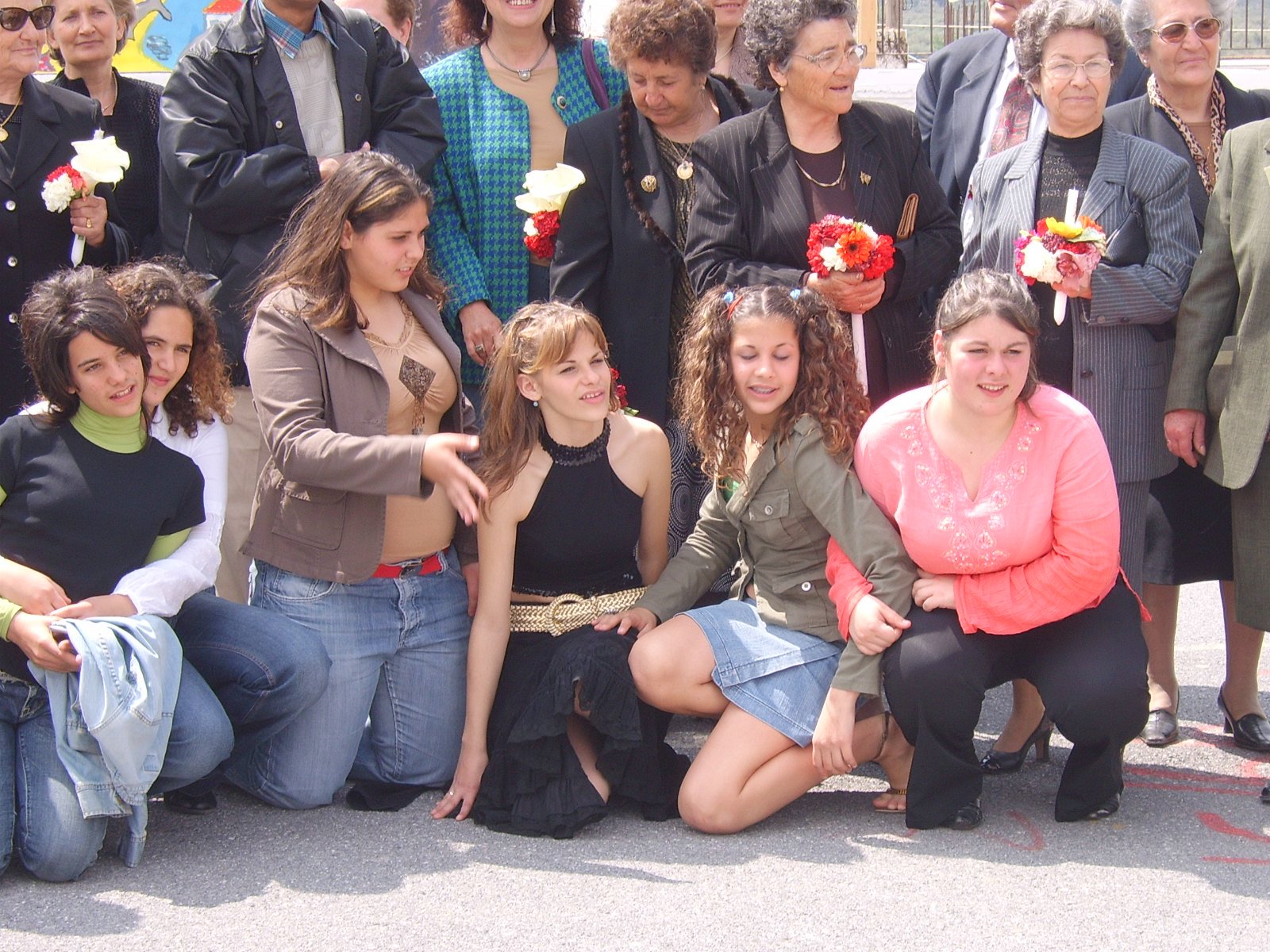Explaining the exhibition and workshops
After the church service on Easter Sunday, the priest said to the congregation no one goes home, but all of us shall go to see the exhibition. It contains murals which children have painted in search for peace.
This prompted a walk through the exhibition. Given the murals coming from different countries, that can be compared to a journey through the world, a kind of traveling from country to country. Naturally, explanations can facilitate a gain of insights otherwise not seen, if this dialogue between imagination and perception of the mural has not been started. Moreover by talking out aloud what is seen, more and more details become suddenly apparent. Although there all the time, they are not perceived right away.
Altogether explaining the murals amounts to making possible further going experiences. They can point in directions not thought of before. The beauty of the murals is that children can easily transform conventional symbols into novel new signs like the meat grinder in the Afghanistan mural: tools of wars are thrown in and out come tools needed for learning at school.
Meat grinder (detail of Kabul, Afghanistan mural)
Murals as big letters
Since these murals can be perceived as big letters which children have painted before wishing to send them into the world, they should be read as to what children are most concerned about. For they see a world which is too often at war and therefore far away from any notion of peace.
However, receptivity of these murals is just important task which a well conceived exhibition has to fulfil. Since the children wish to communicate what they dream and imagine independent from what they often experience only as something negative, there has to be a response to what they express. It becomes, therefore, crucial on how Kids' Guernica answers these letters coming in from all corners of the world.
The dialogue of the imagination which these murals make possible is a part of a literacy the world needs if violence and abuse of especially children is to be faced openly, equally peacefully. Thomas Economacos from Poiein kai Prattein would, therefore, try to make children understand right from the beginning when about to paint such a mural that there is already a difference between an aggressive way of posing questions and a peaceful approach to the other when wishing to pose a further going question. Thus the inherent philosophical logic of any peace mural is related to the prime question the children and youth pose themselves when setting out on this collaborative learning process.
At another level, these murals stand really at the beginning of a new epoche of art history. They are not recognized as of yet as art works, but a lot can be gained by seeing what aesthetical principles evolve when compared, for instance, with Picasso and how he conceived Guernica. For the treatment of such a huge space entails as well a differentiation of how to view the relationships between the parts and the whole. Since Matisse this has become an ever greater issue, and reflects parallel to that the transition made in philosophy, insofar as Hegel could still acclaim 'the whole is the truth' while Adorno countered after 1945 and the disaster Europe incurred under Fascism 'that the whole is not the truth'. This has immediate relevance for how any coordinator or adult works with the children and youth, since the real story of these murals is that the whole outcome remains till the last moment a surprise. It is not determined at the beginning.
The murals can involve also education in schools, but not in terms of how to place the painting of a mural under similar formal rules as any art educational course does at school. Rather something else is meant, namely 'intercultural learning'. For the murals can be used as entry point for getting to know another country. Since all these murals are accompanied by a rich documentation, children and youth can identify easily with the children who are in Afghanistan, Libanon, Chicago etc. and painted this specific mural.
For instance, Fatema Nawaz from Afghanistan brought with her along a video depicting how a boy of 11 years of age had to earn the money for the bread needed to feed his younger sister and brother. The parents had vanished. The documentation shows what ordeals he has to go through first of all to do his job well, namely to sell cigarettes, and then to satisfy his 'pimp', or the man who gives him the cigarettes and to whom he must return the money. He can keep only a fraction thereof for himself and his sister and brother. In the film the man gives him even a kick so that he and the board on which he has all cigarette boxes land in the gutter. Extreme conditions. Heavy to see. But it can bring something across as to which conditions there exist once no longer parents are around and no one to look after you to have something to eat in the evening. Also such a film will not highlight only Afghanistan, but the risk of any child once abandoned and thrown out into the street where he or she must learn to survive in a world hardly meant for children.
'Intercultural learning' can be promoted by these murals. Explaining the exhibition is, therefore, a way to get to know the conditions under which these murals were painted. This intercultural learning stands to further friendships for children easily identify themselves with their compatriots once they realize alhough of the same age, they are exposed to quite different conditions than themselves. For instance, the children from Katmandu in Nepal had to go through front lines before they could reach the foot hills of the Himalya, and once there, enter a dialogue with the children from the village. This was reaccounted in the opening speech by Sachi.
Painting these murals is an informal process
The painting of these murals should be made possible by ensuring children and youth are in an informal setting. It should be like playing in the streets where they can learn themselves to set the rules. Piaget gave already some interesting insights as to what can happen when children play marbles. Amazing is what concept of morality they develop, and then impose themselves some rules e.g. if you do not clip your marble properly, you lose a turn, you lose your marble, you are expelled from the game. It would be an interesting study as to what happens in terms of morality when children are really left alone and therefore expose each other to this informal learning process? The importance of that cannot be stressed enough. Too much is lost when education is reduced to a formal learning process, and everything is evaluated according to set standards and rules. They have enough of that at school. It would be quite a contradiction if Kids' Guernica would develop in that direction and let only actions happen under the supervision of teachers who must make sure nothing goes 'wrong'. That would not allow the degree of freedom needed if the children are to free with their strong wishes and souls touching the canvas all those who have lost communication with their imagination, and since this includes almost all adults and therefore teachers, it would contradict the essence of a mural being the outcome of an informal process.
As for time, painting together such a mural is an open ended process, and can take weeks, if not months. The more time the children and youth have to explore themselves what they wish to express, the greater the chance to reflect over time what is peace? That is after all a very difficult and complex theme. For can peace be really defined independently from war? There are naturally many associations children can make e.g. a peaceful home is one in which the parents are not constantly quarreling. The process of time can thus deepen their understanding. By talking with their parents and others at home about they experienced during the day, suddenly the grandfather may reaccount something never heard before from him. Then the children will not see war as absence of peace, but as something others have gone through and still remember to date what it was like when in fear of life. They will come back the next day and add something to the mural. It may be just a detail but without that feedback from home, they would never have conceived it.
Also by entering such a process, the relationships between the children changes, and they find suddenly space for their imagination to explore many other things.
As to how many children or youth should be involved, practical examples speak for themselves. In the end the number does not matter, what counts is how all get involved in the painting process. For instance, Fatema Nawaz had in Kabul, Afghanistan 200 children who all wanted to paint. They had never held in their hand before a paint brush. Naturally she could not let all at once into the room where the canvas was. Consequently all of the children lined up and waited patientaly to take their turn, 20 at a time, to add something to that amazing mural from Kabul, Afghanistan.
In the case of Poein kai Prattein's mural "The War is over", three groups of children were involved: two to three year olds, seven to nine year olds, and two sixteen year olds. Also during one day of action an entire kindergarten group spread over the canvas to continue what had already been started by the neighborhood kids. In the case of the Japanese mural, there were supposedly involved 80 people ranging in the age from two to eighty. Crucial is that all join in this collaborative learning process, and thereby avoid that adults tell children how to paint.
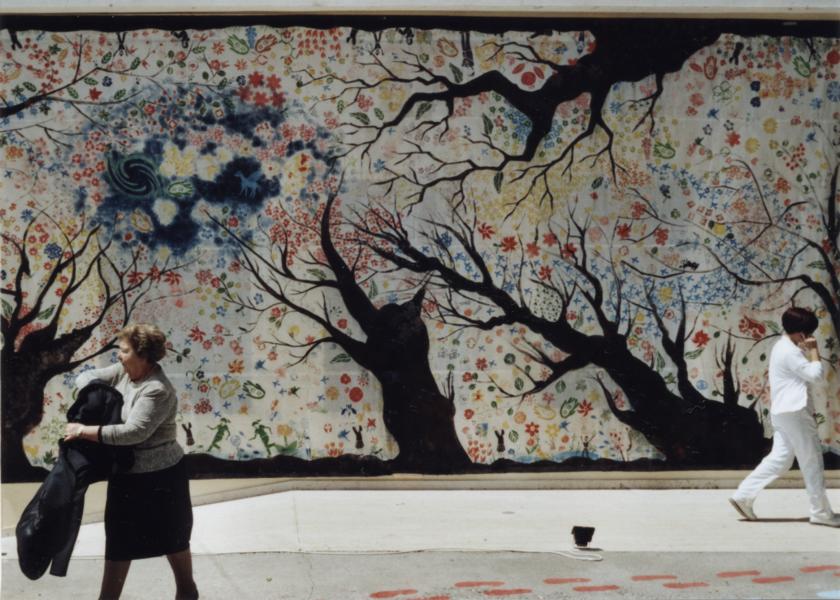
People passing the Japanese mural
The Japanese mural is on rice paper, and therefore very light, hence also easy to be transported by simply folding it. Since dedicated to the cherry blossoms which are celebrated every year for about two weeks, Takuya Kaneda explained a saying in Japan, namely 'that life is as sweet as short as the cherry blossoms'. It underlines something to think of oneself as being akin to a brevity of life.
Bridges of understanding
The role taking of a Kids’ Guernica painting is, therefore, to help construct new bridges of mutual understanding. It does help at times to take down these premonitions about the others only possible when children can enter together a collaborative work process and find out how easy it is to get along with the other while painting side by side.
Overcoming invisible borders
Imprison war, Germany 2006
Interesting was what Fatama Namez reaccounted about the second painting she did after Kabul, namely in Germany. She started off with the children painting in a Christian church and then they moved on for the second half of the painting to a Turkish mosque. Interestingly enough some of the German parents did not give permission for their children to follow that part of the action. To deal with such borders drawn by prejudice as much as lack of knowledge, this meant to become sensitive to how intercultural worlds are not easily brought together nor that things can be left at that.
Towards a new symbolic language of peace
Detail of the Kastelli Mural 2006
There were men in the platia of Kastelli who expressed scepticism about murals able to achieve peace. They were weary of yet another white pigeon being painted. Although since Picasso this symbol of a white pigeon stands for peace, the very repetition thereof has contributed to being tired of such a symbolic language. So there is a need to take another look at the murals and to make the effort to see if there is a new symbolic language in the making. In the case of the Chios mural, one bird is painted in blue colour to bring it close to the sky while the other has the colour of the earth.
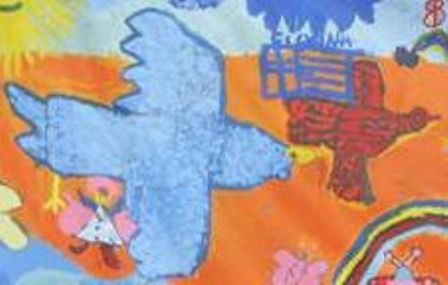
Of interest is altogether what new symbolic language shall emerge over time as more murals will be painted around the world! There is already this lovely image of a sun wearing sun glasses painted by children of Chios aged 2 to 3.

If a cultural action is to become a community wide one
Almost always these murals are started out by one or two individuals grasping the idea, and once convinced it can be done with a bunch of kids, all what it takes is to obtain the canvas of that size, paint brushes, paint and place where the process can take place over time, and undisturbed. That mean support is needed and not always scepticism can be overcome right away. One prime reason is that the size of the canvas is a huge challenge for any artist, so why should children fare better?
In Kastelli not many came right away to see the exhibition, others drove in and out on their motorcycles in the evening, that is when no one was around. There are numerous types of constraints in any community. Some voiced even stronger objections to this kind of action: a Kids' Guernica action. They perceived it as a publicity stunt by the mayor seeking re-election in the autumn.
So a wider support of the community was not self evident at the beginning but can be gained once people receive some explanations as to what each of these paintings contain.
Explaining the exhibition
Weaving through the various activities, experiences were made which showed a way of how optimism in a world can be created, or at the very least can be brought about by adopting a friendly attitude. That reminds of Cassirer who stated that only a friendly attitude towards the world could provide the very much needed basis for creativity.
Indeed, once people can get together in open spaces, they free each other from not only fears about the state of the world, but also from a certain loneliness when feeling helpless due to all the wars and atrocities being committed all the time. Kids' Guernica murals add to this a dimension of what does constitute a meaningful action in such a world.
The exhibition included peace posters send by Kate Parker who could not come herself, but her students at school outside of London made them. Kate would join the Kids' Guernica exhibition and activities held in the following year in Chios 2007.
Work shops
Children in the workshop - in the backgrond the peace posters of Kate Parker's school in London
In the workshops a lot of fun was created by the Japanese delegation showing new forms of dance. Besides body and mind, they used the hands as another way to express emotions, thoughts and meanings.
Dance motions - peace notions
All the children received Kids' Guernica T-shirts - a special idea by Nicholas Spetsidis who took care of almost everything.
During one special motion, some observations on how Cretan children are brought up could be made. They were not so easily free to trust the others. For example, when it was time to close the eyes and let the body fall into the hands of the children forming a circle, they were highly reluctant to do so.
However, they enjoyed doing dances with Ms. Kaneda who showed them with the help of Sachi and Heiko motions known in Japan and Nepal. There was much laughter in the air. And Maria Briant added a special touch by giving them some idea of Pantomime.
Some observations
More so in discussions too often certain people of the community look on and remain silent rather than engage themselves. Always there are the politicians and experts who speak in public. Moreover any such action involving a considerable number of people means observations are made on how this community life presents itself and what can be gauged out of the responses to these peace paintings by the children.
There were opinions expressing scepticism about a white pigeon standing really for peace while others voiced even stronger objections to these kinds of actions as they were perceived as a publicity stunt by the mayor seeking reelections in the autumn. So the support gained is not self evident at the beginning but can become fruitful especially when people receive some explanations as to what each of these paintings contain.
In that sense, there were needed guided tours as much as an effort to interpret these paintings done by children all over the world in order to take the discussion further. This involves art historical interpretations and the creation of an archive with Picasso’s Guernica painting itself an invaluable departure point for it has received much criticism but also ongoing reflections show how both the technique and the theme are still relevant today.
After all Kids’ Guernica is much more than just the paintings. Once it becomes a community based action, it involves potentially all citizens and therefore this can change the level of debate about war and politics. Once people see a beginning can be made with children learning to work together and when an international group can organize with the help of locals such an event, the main outcome of that is a real endorsement of such ‘informal learning’ as prerequisite of peace in this world.
Takuya Kaneda has touched upon similar experiences made when students organize Kids’ Guernica workshops in Japan, insofar as the value is intensified as soon as an entire community gets involved. At the same time, his students learn to value the support obtained from the parents of the children, relatives, friends, and people from the community in general.
Takuya Kaneda with group who had visited the exhibition on Easter Sunday
Conclusion
These then are altogether Kids' Guernica related experiences in need of further going reflections. Quite another methodology and interest is evoked, if it is proposed that an evaluation should be undertaken so as to validate whether or not a real progress towards peace in the world has been made due to these murals. Also it does not include as of yet whether or not art education is ready to embrace this informal learning process. The latter is the very reason why these actions are not so easy to evaluate as they are unique and an expression of special circumstances. They are the outcome of real life situations and yet if not directly, then at least indirectly they can help achieve social justice and contribute towards peace as aesthetical resistance against war.
Hatto Fischer
Kastelli 2006 (updated 28 July 2013)
« With poetry against war | An artist's view of Kastelli: Asit Poddar »

